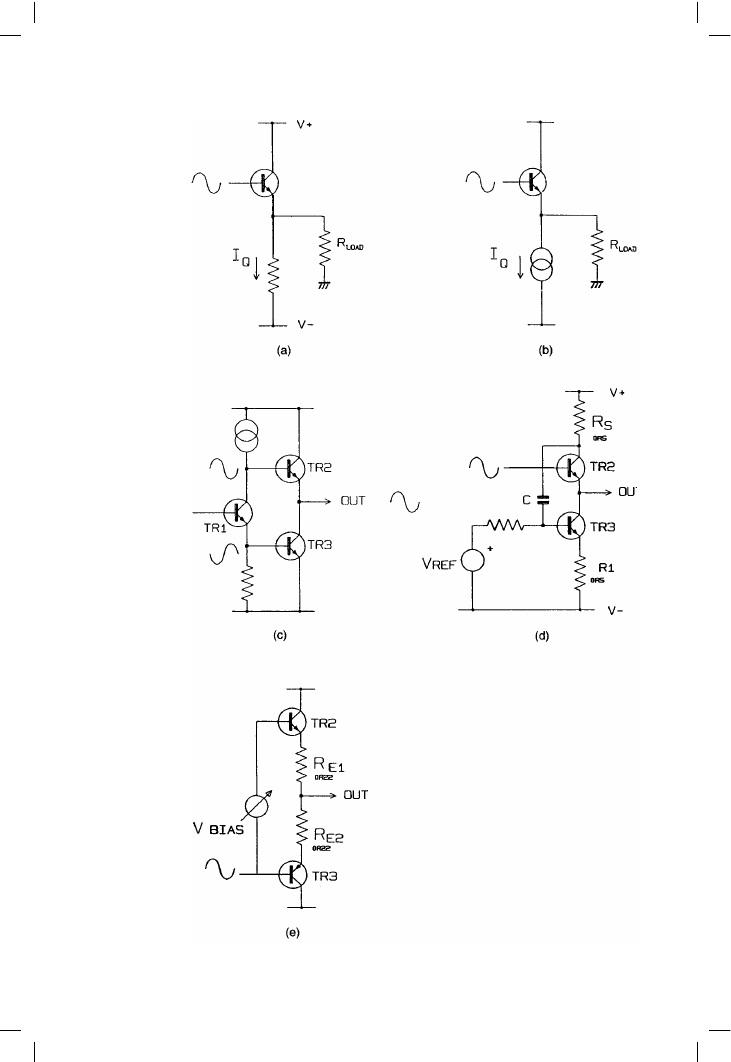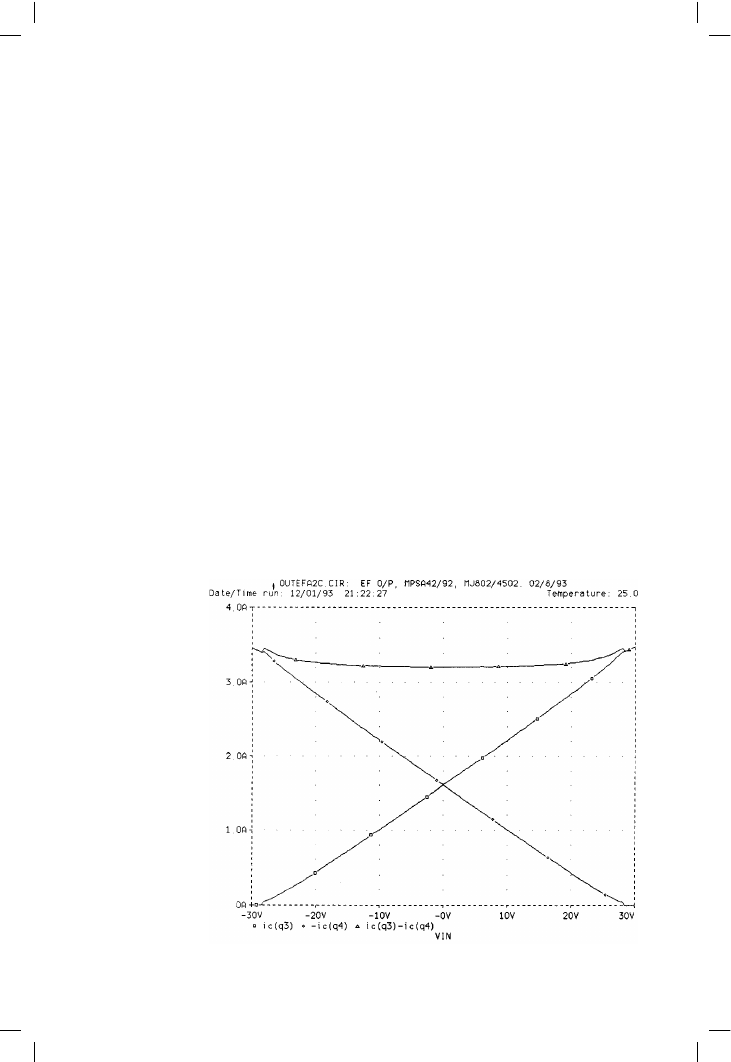ВУЗ: Казахская Национальная Академия Искусств им. Т. Жургенова
Категория: Учебное пособие
Дисциплина: Не указана
Добавлен: 03.02.2019
Просмотров: 17410
Скачиваний: 18

9
Class-A power amplifiers
An introduction to class-A
The two salient facts about Class-A amplifiers are that they are inefficient,
and that they give the best possible distortion performance. They will never
supplant Class-B amplifiers; but they will always be around.
The quiescent dissipation of the classic Class-A amplifier is equal to twice
the maximum output power, making massive power outputs impractical, if
only because of the discomfort engendered in the summer months.
However, the nature of human hearing means that the power of an
amplifier must be considerably increased to sound significantly louder.
Doubling the sound pressure level (SPL) is not the same as doubling
subjective loudness, the latter being measured in Sones rather than dB
above threshold, and it appears that doubling subjective loudness requires
nearer a 10 dB rather than 6 dB rise in SPL
[1]
. This implies amplifier power
must be increased something like ten-fold, rather than merely quadrupled,
to double subjective loudness. Thus a 40 W Class-B amplifier does not
sound much larger than its 20 W Class-A cousin.
There is an attractive simplicity and purity about Class A. Most of the
distortion mechanisms studied so far stem from Class B, and we can
thankfully forget crossover and switchoff phenomena (Distortions 3b, 3c),
non-linear VAS loading (Distortion 4), injection of supply-rail signals
(Distortion 5), induction from supply currents (Distortion 6), and erroneous
feedback connections (Distortion 7). Beta-mismatch in the output devices
can also be ignored.
The only real disadvantage of Class-A is inefficiency, so inevitably efforts
have been made to compromise between A and B. As compromises go,
traditional Class-AB is not a happy one (see Chapters 5 and 6) because
when the AB region is entered the step-change in gain generates
significantly greater high-order distortion than that from optimally-biased
255

Audio Power Amplifier Design Handbook
Class-B. However, a well-designed AB amplifier does give pure Class-A
performance below the AB threshold, something a Class-B amp cannot
do.
Another possible compromise is the so-called non-switching amplifier, with
its output devices clamped to always pass a minimum current. However, it
is not obvious that a sudden halt in current-change as opposed to complete
turn-off makes a better crossover region. Those residual oscillograms that
have been published seem to show that some kind of discontinuity still
exists at crossover
[2]
.
One potential problem is the presence of maximum ripple on the supply-
rails at zero signal output; the PSRR must be taken seriously if good noise
and ripple figures are to be obtained. This problem is simply solved by the
measures proposed for Class-B designs in Chapter 8.
Class-A configurations and efficiency
There is a canonical sequence of efficiency in Class-A amplifiers. The
simplest version is single-ended and resistively-loaded, as at Figure 9.1a.
When it sinks output current, there is an inevitable voltage drop across the
emitter resistance, limiting the negative output capability, and resulting in
an efficiency of 12.5% (erroneously quoted in at least one textbook as 25%,
apparently on the grounds that power not dissipated in silicon doesn’t
count). This would be of purely theoretical interest – and not much of that
– except that a single-ended design by Fuller Audio has recently appeared.
This reportedly produces a 10 W output for a dissipation of 120 W, with
output swing predictably curtailed in one direction
[3]
.
A better method – Constant-current Class-A – is shown in Figure 9.1b. The
current sunk by the lower constant-current source is no longer related to the
voltage across it, and so the output voltage can approach the negative rail
with a practicable quiescent current. (Hereafter shortened to Iq). Maximum
efficiency is doubled to 25% at maximum output; for an example with
20 W output (and a big fan) see Nelson
[4]
. Some versions (Krell) make the
current-source value switchable, controlling it with a kind of noise-gate.
Push-pull operation once more doubles full-power efficiency, getting us to
a more practical 50%; most commercial Class-A amplifiers have been of
this type. Both output halves now swing from zero to twice the Iq, and least
voltage corresponds with maximum current, reducing dissipation. There is
also the intriguing prospect of cancelling the even-order harmonics
generated by the output devices.
Push-pull action can be induced in several ways. Figures 9.1c, d show the
lower constant current-source replaced by a voltage-controlled current-
source (VCIS). This can be driven directly by the amplifier forward path, as
in Figure 9.1c
[5]
, or by a current-control negative-feedback loop, as at
256

Class-A power amplifiers
Figure 9.1
The canonical
sequence of
Class-A
configurations. c, d
and e are push-pull
variants, and
achieve 50%
efficiency. e is
simply a Class-B
stage with higher
Vbias
257

Audio Power Amplifier Design Handbook
Figure 9.1d
[6]
. The first of these methods has the drawback that the stage
generates gain, phase-splitter TR1 doubling as the VAS; hence there is no
circuit node that can be treated as the input to a unity-gain output stage,
making the circuit hard to analyse, as VAS distortion cannot be separated
from output stage non-linearity. There is also no guarantee that upper and
lower output devices will be driven appropriately for Class-A; in Linsley-
Hood
[5]
the effective quiescent varies by more than 40% over the cycle.
The second push-pull method in Figure 9.1d is more dependable, and I
have designed several versions that worked well. The disadvantage with
the simple version shown is that a regulated supply is required to prevent
rail ripple from disrupting the current-loop control. Designs of this type
have a limited current-control range – in Figure 9.1d TR3 cannot be turned
on any further once the upper device is fully off – so the lower VCIS will not
be able to respond to an unforeseen increase in the output loading. In this
event there is no way of resorting to Class-AB to keep the show going and
the amplifier will show some form of asymmetrical hard clipping.
The best push-pull stage seems to be that in Figure 9.1e, which probably
looks rather familiar. Like all the conventional Class-B stages examined in
Chapters 5 and 6, this one will operate effectively in pure push-pull Class-A if
the quiescent bias voltage is sufficiently increased; the increment over Class-
B is typically 700 mV, depending on the value of the emitter resistors. For an
example of high-biased Class B see Nelson-Jones
[7]
. This topology has the
great advantage that, when confronted with an unexpectedly low load
impedance, it will operate in Class-AB. The distortion performance will be
inferior not only to Class-A but also to optimally-biased Class-B, once above
the AB transition level, but can still be made very low by proper design.
The push-pull concept has a maximum efficiency of 50%, but this is only
achieved at maximum sinewave output; due to the high peak/average ratio
of music, the true average efficiency probably does not exceed 10%, even
at maximum volume before obvious clipping.
Other possibilities are signal-controlled variation of the Class-A amplifier
rail voltages, either by a separate Class-B amplifier, or a modulated switch-
mode supply. Both approaches are capable of high power output, but
involve extensive extra circuitry, and present some daunting design
problems.
A Class-B amplifier has a limited voltage output capability, but is flexible
about load impedances; more current is simply turned on when required.
However, Class-A has also a current limitation, after which it enters Class
AB, and so loses its raison d’ˆetre. The choice of quiescent value has a major
effect on thermal design and parts cost; so Class-A design demands a very
clear idea of what load impedance is to be driven in pure A before we
begin. The calculations to determine the required Iq are straightforward,
though lengthy if supply ripple, Vce(sat)s, and Re losses, etc. are all
258

Class-A power amplifiers
considered, so I just give the results here. (An unregulated supply with
10,000 µF reservoirs is assumed.)
A 20 W/8 ! amplifier will require rails of approx. +/–24 V and a quiescent
of 1.15 A. If this is extended to give roughly the same voltage swing into
4 !, then the output power becomes 37 W, and to deliver this in Class-A the
quiescent must increase to 2.16 A, almost doubling dissipation. If however
full voltage swing into 6 ! will do (which it will for many reputable
speakers) then the quiescent only needs to increase to 1.5 A; from here on
I assume a quiescent of 1.6 A to give a margin of safety.
Output stages in Class-A
I consider here only the increased-bias Class-B topology, because it is
probably the best approach, effectively solving the problems presented by
the other methods. Figure 9.2 shows a Spice simulation of the collector
currents in the output devices versus output voltage, and also the sum of
these currents. This sum of device currents is in principle constant in Class-
A, though it need not be so for low THD; the output signal is the difference
of device currents, and is not inherently related to the sum. However, a
large deviation from this constant-sum condition means increased ineffi-
ciency, as the stage must be conducting more current than it needs to for
some part of the cycle.
259
Figure 9.2
How output device
current varies in push-
pull Class-A. The sum
of the currents is near-
constant, simplifying
biasing